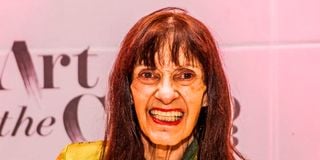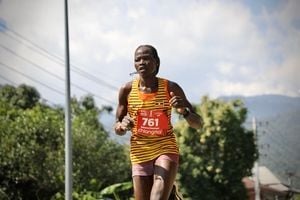Margaretta, a woman with a fierce and ferocious love for arts

Margaretta wa Gacheru poses for a photo at The Artcaffe Riverside in Nairobi.
I was in the middle of telling you about Prof Egara Kabaji’s Maragoli Dictionary when the thunderbolt news hit me. Margaretta wa Gacheru, Ma’Migwi, was dead. Everything around me seemed to come to a standstill.
I was petrified (nilipigwa na butwaa). To make matters worse, I was all alone, in my writing bunker, with no one with whom to share my shock and sorrow.Off the cuff, I shared with my social platform friends an apostrophic eulogy of the fallen sister, in words like, “Fare you well, Margaretta, our sister from Sagana, fierce and indefatigable lover of the arts in all their forms, and of us who labour and toil in the creative shambas.
You also led bands of us who came and fell in love with Kenya.”I learnt from an article by our colleague, Gakiha Weru, that Margaretta had a shamba in the Sagana neighbourhood and I thought that it was an appropriate “home square” city to associate with her.
Weru’s article, “Margaretta wa Gacheru: My 40-year Love Affair with Kenyan Art”, is still available on various platforms of the media.It is based on Margaretta wa Gacheru’s autobiographical conversations with the author. It captures beautifully Margaretta’s tumultuous transition from the middleclass American background of her upbringing to the bohemian riot of Nairobi’s artistic community of the past half century.
We might not all agree on every aspect of Margaretta’s views on Kenyan Literature, music, visual arts or theatre. But I believe we all recognise her as the undisputed Queen and oracle of Kenya’s creativity in our times.
Through her hundreds, maybe thousands, of reports, reviews and critical responses to our artistic endeavours, Margaretta wa Gacheru established herself as the sovereign of the awareness, the view and the taste of all intelligent consumers of Kenyan art in our generation.
Unlike many of us who both dabble in creating, performing and exhibiting our creativity and then turn around to comment on it and that of others, Margaretta earned her laurels through being strictly audience and critic of the show. I do not remember her participating directly in a performance or any other artistic presentation.
Yet her perennial audience/critic role stamped an authoritative power on our activities and alerted us to the crucial role of a responsive audience in our activities. One of my longtime friends, Njeri Luseno Osaak, on receiving news of Margaretta’s passing, remarked that she was a great friend of the Nairobi University Players. “She wrote countless reviews (some scathing!) on our plays and performances that helped sell tickets.”The Nairobi University Players (NUP) was the leading theatre outfit founded by John Ruganda in the mid-1970s and was responsible for the premiere performances of many East African theatre classics.
NUP also contributed significantly to the careers of such theatre greats as David Mulwa, (now Prof) Oluoch Obura, John Sibi Okumu, Paul Onsongo and the late Francis Imbuga, Sidede Onyulo and Stella Muka, apart from Njeri Luseno herself.It would be fascinating to look back and see what “scathing” remarks Margaretta wa Gacheru made of us in those days. (You see, I was one of the crowd, having joined in 1978).
Margaretta entered the arts, and especially theatre, reviewing scene at a rather delicate point when several forces were in fierce contention for both ideological and physical space, including the Kenya National Theatre.
At one extreme were the remnants of the pre-independence crowd, mostly white, who regarded theatre (meaning supine exports from British suburban repertory shows) as their preserve.
At the other extreme were the fiery revolutionaries, Ngugi wa Thiong’o, Micere Mugo and their disciples, who saw and practised the arts, including theatre, as a fighting tool.
Somewhere in the middle, were the creative pragmatists, like the late Ghanaian Joe de Graft and John Ruganda, and their students, like David Mulwa and the late Francis Imbuga, who believed in a liberal and multi-pronged approach to the arts.
Taking over the mass media critical mantle from scribes like the rather conservative Ms Heine and the benevolent Nigel Slade, Margaretta wa Gacheru seems to have zeroed in on us pragmatists, as Njeri Osaak’s memories suggest.
But most of us who interacted with Margaretta wa Gacheru in our palaver on creativity attribute her phenomenal success to three main traits in her character and approach to work. The first is her razor-sharp intelligence and vast education in matters artistic and creative.
Secondly, we may mention her impeccable and incisive communication style. When Margaretta made a remark about a show or an event, her readers knew exactly what she meant. This is what brought people to the shows, or kept them away if, in her devastating frankness, she said they were below par.
But above all, Margaretta wa Gacheru won our hearts with two gifts which I think were closely related.One was her absolutely boundless energy in pursuing creative activities in Nairobi and its environs. I have told you of people who are believed to have the gift of being in more than one place at a time.
That is what Margaretta wa Gacheru looked like to some of us dawdlers who think we have done a lot by covering one book launch in a week.Margaretta would attend, and meticulously review, an art exhibition, a theatre or musical performance, a book fair and a major scholarly lecture all in one week. I think the secret to all this was her fierce and ferocious love.
One of our friends said that you did not have to make friends with Margaretta. She was “always already” programmed to be friends with you. Margaretta genuinely loved people and always had a lively interest in their activities, especially the creative activities. That is how she came to be the discoverer and patroness of many, now-famous, artists and art communities that we might otherwise never heard of.
I noted with gratitude that she was recently making great efforts to promote female visual artists. How should we appropriately celebrate Margaretta, Ma’Migwi, wa Gacheru?





